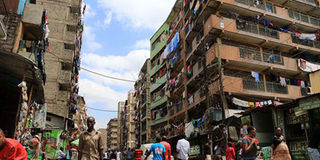MY VIEW: It must be very painful living in those tall flats

There are those residential houses constructed with so many rooms crammed into one multi-storeyed building that they often make life look like staying in a compartmentalised chicken cage. PHOTO | FILE | NATION MEDIA GROUP
What you need to know:
- There are those residential houses, more so in the estates on Mombasa Road and Thika Superhighway, which are constructed with so many rooms crammed into one multi-storeyed building that they often make life look like staying in a compartmentalised chicken cage.
- Sometime last year, I visited one such dwelling in Nairobi’s Embakasi area and it immediately evoked memories of my university hostel.
- I hated the Embakasi house when my phone lost its network connection a few floors up the staircase as we headed to the rooftop for an interview.
Ever since I read an article by Dr Nelly Bosire in magazine about rickets plaguing children raised in some high-rise buildings, I have been agonising about the pain people undergo while staying in these houses.
There are those residential houses, more so in the estates on Mombasa Road and Thika Superhighway, which are constructed with so many rooms crammed into one multi-storeyed building that they often make life look like staying in a compartmentalised chicken cage.
Sometime last year, I visited one such dwelling in Nairobi’s Embakasi area and it immediately evoked memories of my university hostel. Hostels were made to accommodate as many people as possible in as little space as possible, and it appears their design has been replicated by architects of the high-rise buildings springing up everywhere.
Instructively, the house has been constructed in a U-shaped manner, with blocks of residential rooms all over the three sides of the “U”— just like the hostel.
I hated the Embakasi house when my phone lost its network connection a few floors up the staircase as we headed to the rooftop for an interview. Apparently, our side of the building was on a network “shadow”, meaning the mobile signal could only reach there after pouring libation to the ancestors.
I wondered how the residents cope with such a weak phone signal. I pitied whoever stays on that wing, wondering whether they wait for 30 years before a juicy video shared on a WhatsApp group can fully download when everybody else is reacting to it with the “rolling on the floor” emoji.
And my legs, not the fittest pair I must say, were aching by the time we reached the topmost floor, a place filled with television aerials and clothes lines.
I don’t remember the exact number of storeys that building has, but they must have been more than five. And that poses a challenge. A parent living in such a house, I thought, can unknowingly deprive their toddlers of sunlight in an effort to protect them.
SAFETY
The reason is that the staircase is a hazard to any minor and a parent would like to keep the young ones as far away as possible. Besides, these are places housing hundreds of people, with some rooms having a high turnover. So, a parent may be apprehensive about letting their child move about the building.
There was no playground around that huge residential, and it seemed capitalism had driven the owner of the property to commercialise every inch of it. Where the young children will get enough space to play is anybody’s guess.
I think the problem can be half-solved by having lifts. But as it stands, it is only on paper where Kenyan developers have to install lifts in any building with more than five storeys. Most of the high-rise buildings I have visited do not even have an indication that a lift will ever be installed on them, and I feel for the people who reside there.
I feel for the sickly person who has to walk the stairs six or more floors up, and at times that person is a mother required to carry water, food or other heavy items for her family.
I sympathise with the toddlers who find themselves there, the worst place being basement rooms where sunlight, one of the sources of Vitamin D that checks against rickets, sounds like an imported commodity.
My heart equally bleeds for the distrust that is inculcated among children who grow up in such houses from a young age. I am sure the conversations in the household take the form of: “Don’t leave your shoes outside the door; they will be stolen”; “Somebody stole our clothes from the line”; “Never eat at Neighbour X’s place.”
With such, children grow up thinking everyone is after their property. Such is the reality of modern living, but I think with better design, some of these conflicts can be avoided.
Recently, a friend who lives at such a high-rise house in Kasarani lost all his household items after visiting his rural home. The fact that no one saw the thief led him to conclude that a neighbour with itchy fingers had been observing him and chose the opportune time to strike.
Whatever it was, it is high time people discussed the design of some residential houses and the impact it has on the health, comfort and security of its residents.
[email protected] Elvis Ondieki is a reporter with Nation





